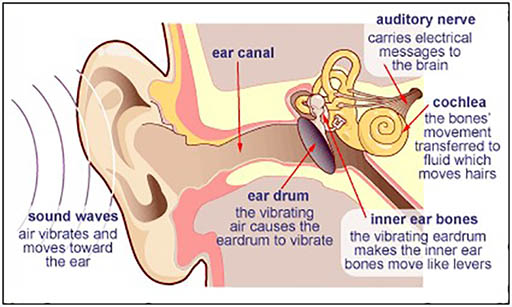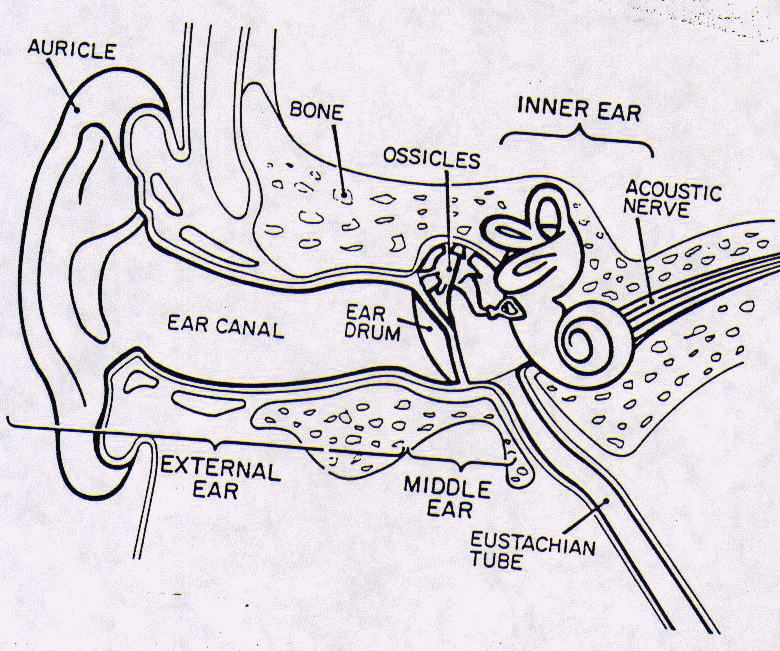The ear is a magnificent organ. The outer ear directs sound waves from the external environment to the tympanic membrane.

Olcreate Tessa Kny Module 3 Science Energy And Movement Resource 2 Sound Waves Teacher Notes
The ossicles are actually tiny bones the smallest in the human body.

. These three sections are the outer ear middle ear and inner ear. As the sound waves pass through the ear the ear converts them into electrical impulses which are then translated by the brain into useful information such as speech or music. In bone conduction oscillating air hits the outside of the skull and makes it oscillate slightly.
The outer ear the middle ear and the inner ear. The tympanic membrane is a very thin structure that. The auricle the visible portion of the outer ear collects sound waves and with the concha the cavity at the entrance to the external auditory canal helps to funnel sound into the.
Sets with similar terms. The vibrations produced by the objects reach until the eardrum through the air. Transmission of sound waves through the outer and middle ear Transmission of sound by air conduction.
The vibrations stimulate small hair cells in the inner ear which transforms them into. It first enters the ears through the funnel-shaped outer part of the ear. The video teaches viewers about.
To do this the ear uses three different sections each designed perfectly to do a unique job. Transmission of sound within the inner ear Transmission of sound waves in the cochlea The mechanical vibrations of the stapes footplate at the oval window creates pressure waves in the perilymph of the scala vestibuli of the cochlea. The external earpinna funnels sound waves into a unidirectional wave and is able to direct it into the auditory canal.
A sound wave is funnelled into the ear canal by the pinna the vibrations in the air make the eardrum vibrate these vibrations are passed through the three small bones called ossicles to. Hearing via bone conduction is not as effective as air conduction hearing. The outer ear consists of the visible portion on the side of the head known as the pinna 1 and the external auditory canal ear canal 2.
Eardrum plays an important role in the functioning of the ears. The three bones are named after their shapes. The purpose of the pinna is to catch sound waves amplify them slightly and funnel them down the ear canal to the tympanic membrane eardrum 3.
The louder the sound the bigger the vibration the lower pitch the sound the slower the vibration. A sound wave enters the outer ear then goes through the auditory canal where it causes vibration in the eardrum. The vibrations from the eardrum set the ossicles into motion.
The Nature of. The vibration makes three bones in the middle ear move. As sound hits the pinna it filters and amplifies sound waves and chutes them along into the ear canal Dr.
Sound waves cause the eardrum to vibrate. Once the sound waves have passed the pinna they move into the auditory canal external acoustic meatus before hitting the tympanic membrane eardrum. The vibrations move through the fluid in the cochlea in the inner ear stimulating.
Sound waves must have a medium to pass through such as air. Sound can reach the ear via air conduction or bone conduction. This in turn causes three small bones in the middle ear to move.
This sound then reaches the tympanic membrane and causes it to vibrate. It moves down through a canal till the eardrum the thin membrane is stretched tightly. The sound waves arrive at the pinna auricle the only visible part of the ear.
Sound waves pass from the outer ear and move through the air toward the eardrum which vibrates with sound From the eardrum these sound vibrations pass to the bones in the middle ear then to the cochlea which causes fluid and tiny hair cells in the cochlea to move. Start studying The order that sound waves pass through the ear. Ossicles can increase the vibration up to 15-20 times passing them through to the cochlea in the inner ear.
Sound waves are longitudinal waves that must pass through a medium such as air. Sound waves travel from the outer ear and in through the auditory canal causing the eardrum to vibrate. The sound waves then travel toward a flexible oval membrane at the end of the ear canal called the eardrum or tympanic membrane.
When a sound occurs it enters the outer ear also referred to as the pinna or auricle. Once the sound waves reach the tympanic membrane it begins to vibrate and they enter into the middle ear. The pinna is the visible portion of your ear and its funnel-like shape is well-engineered.
Also known as the tympanic membrane or myringa it is the eardrum which amplifies sound waves through ossicles which are three small bone structures suspended by ligaments allowing them to respond to passing vibrations. Conducted by the liquids in the ear the oscillations reach the hair cells. The frequency of ultrasound is.
The sound produced is in the form of vibration. The ear is divided into three different parts. 5th Grade Science- Sound Units.
What is the seventh part sound travels through. Flow of Sound Through the Ear STUDY Flashcards Learn Write Spell Test PLAY Match Gravity Created by FacelesAngel Terms in this set 8 Step 1 Sound is collected in the Pinna Step 2 Sound travels through the auditory canal Step 3 Sound causes the tympanic membrane to vibrate which converts the sound to mechanical waves. Describe how sound waves pass through the ear.
Echoes are reflections of sounds. Learn vocabulary terms and more with flashcards games and other study tools. The movement causes vibrations that move through the fluid of the cochlea which is located in the inner ear.
The National Institute on Deafness and Other Communication Disorders NIDCD which developed Noisy Planet has produced a two-and-a-half-minute animated video Journey of Sound to the Brain that follows sound waves as they pass through the ear canal and are changed to electrical signals that our brains interpret and understand. Want this question answered.
![]()
What Is Sound Soundproofing Company

Path Taken By Sound Waves Reaching The Inner Ear Sound Travels From The External Environment S External Auditory C Ear Anatomy Inner Ear Anatomy Sensory System


0 Comments